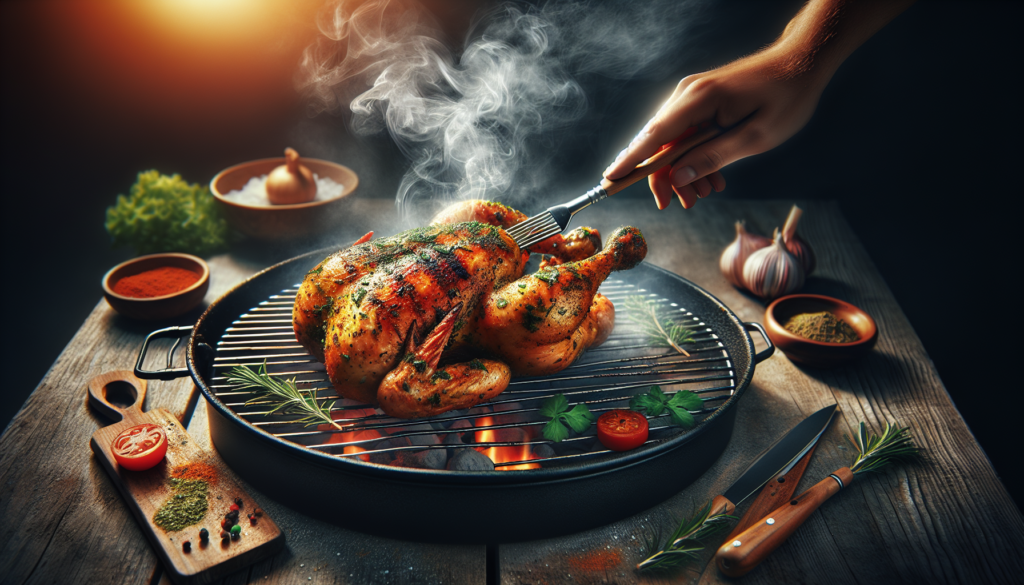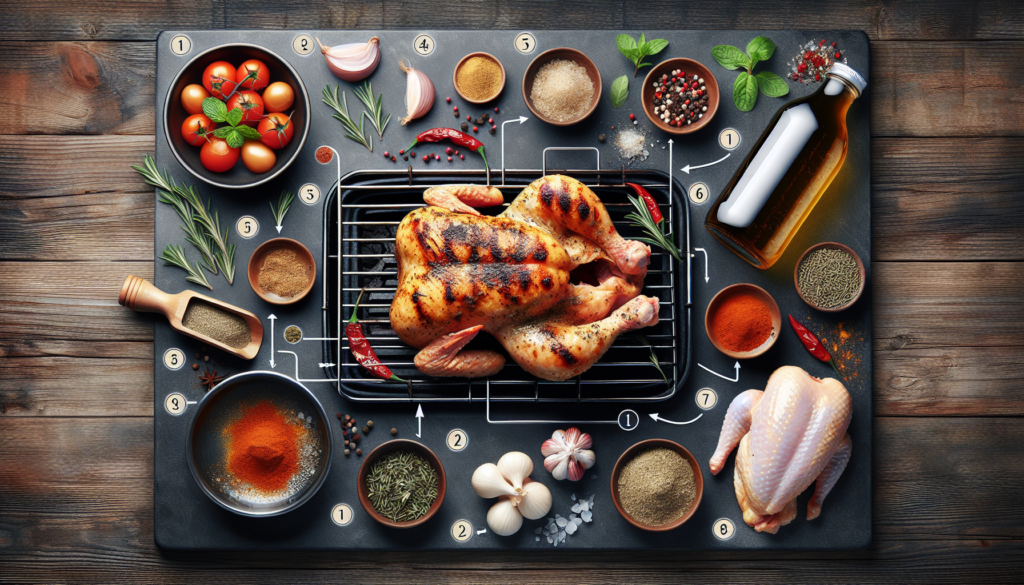Craving some deliciously grilled chicken? Look no further! In this article, you will discover the art of cooking a whole chicken on the grill. Whether you’re a seasoned grilling pro or just starting out, we’ve got you covered with simple steps and helpful tips to ensure that your chicken is juicy, flavorful, and perfectly cooked. Get ready to impress your friends and family with this mouthwatering recipe that will have everyone asking for seconds. Let’s fire up the grill and get cooking!

Preparation
Choose the right chicken
When it comes to grilling a whole chicken, it’s important to choose the right bird. Look for a chicken that is fresh, plump, and free from any unpleasant odors or discoloration. The size of the chicken will also play a role in the cooking time, so consider the number of guests you are planning to serve and choose a chicken accordingly.
Brine the chicken
Brining is a fantastic way to infuse flavor and moisture into your chicken. To brine the chicken, start by dissolving salt and sugar in water, then submerge the chicken in the brine and refrigerate for a few hours. This will ensure that the chicken stays juicy and tender throughout the grilling process.
Prepare the grill
Before you start grilling, it’s essential to make sure your grill is clean and properly prepared. Start by scraping off any residue or debris from the grates, then preheat the grill to the desired temperature. This will help prevent the chicken from sticking to the grates and ensure even cooking.
Seasoning
Basic seasoning
For a classic grilled chicken flavor, a simple seasoning of salt, pepper, and garlic powder goes a long way. Rub the seasoning all over the chicken, both on the outside and under the skin, to ensure that every bite is packed with flavor. Don’t be afraid to get your hands dirty and really massage the seasoning into the chicken for the best results.
Marinades and rubs
If you’re looking to add more depth to the flavor of your grilled chicken, marinades and rubs are the way to go. Marinating the chicken in a mixture of herbs, spices, and liquids will infuse it with incredible flavors. Alternatively, dry rubs made from a combination of various spices can provide a tantalizing crust and enhance the overall taste of the chicken.
Flavor variations
While a well-seasoned chicken can be delicious on its own, there are countless flavor variations you can experiment with. From tangy lemon and herb to spicy chili-lime, there’s a combination of flavors to suit every palate. Don’t be afraid to get creative and try out different seasonings to find your favorite!
Grilling Techniques
Direct grilling
Direct grilling involves cooking the chicken directly over the heat source. This method is perfect for chicken pieces or smaller whole chickens. Simply place the chicken on the preheated grill and cook on each side until the internal temperature reaches the recommended safe temperature.
Indirect grilling
Indirect grilling is a great technique for larger whole chickens. This method involves placing the chicken on the grill away from the direct heat source, allowing it to cook slowly and evenly. The result is a juicy and tender chicken with a crispy skin. To achieve indirect grilling, simply turn off the burners directly under the chicken or place it on the cooler side of a charcoal grill.
Beer can method
The beer can method is a fun and flavorful way to grill a whole chicken. Start by opening a can of beer and taking a few sips to make room in the can. Place the chicken cavity over the beer can, forming a sort of tripod. As the chicken cooks, the beer steams, adding moisture and flavor to the meat. This method not only results in a moist chicken but also creates a dramatic presentation.
Temperature Control
Preheat the grill
To ensure even cooking and prevent sticking, preheat the grill to the desired temperature before adding the chicken. This will help sear the chicken, locking in the juices and creating that beautiful grill marks. Different recipes may require different temperatures, so make sure to adjust accordingly.
Monitoring the chicken
Throughout the grilling process, it’s essential to monitor the chicken closely to avoid overcooking or undercooking. Keep an eye on the color of the skin, adjusting the heat if necessary, and use a meat thermometer to check the internal temperature. This will ensure that the chicken is cooked to perfection, with no pink meat and a temperature that meets the recommended safe levels.
Using a meat thermometer
Investing in a meat thermometer is a game-changer when it comes to grilling chicken. It takes the guesswork out of cooking by providing an accurate internal temperature reading. For whole chickens, the safe internal temperature should reach 165°F (74°C) in the thickest part of the thigh. Insert the thermometer carefully without touching the bone for the most accurate reading.

Cooking Time
Estimating cooking time
Cooking times for whole chickens on the grill can vary depending on the size of the chicken and the grilling method used. As a general guideline, budget approximately 15-20 minutes per pound (0.45 kg) for the cooking time. However, it’s crucial to rely on the internal temperature of the chicken rather than the cooking time alone to ensure it’s thoroughly cooked.
Checking for doneness
To check if your chicken is done, use a meat thermometer to measure the internal temperature. Insert the thermometer into the thickest part of the thigh without touching the bone. If the temperature reads 165°F (74°C), the chicken is safe to eat. If it hasn’t reached the desired temperature, continue grilling and check again after a few minutes.
Grill Maintenance
Cleaning the grill
Regularly cleaning your grill is not only important for hygiene but also for maintaining its performance. After each use, scrape off any food debris from the grates using a grill brush. For a more thorough cleaning, you can also remove the grates and soak them in warm, soapy water. Be sure to clean the interior of the grill to prevent the buildup of grease and residue.
Greasing the grates
To prevent the chicken from sticking to the grill grates, it’s crucial to grease them properly. Before heating up the grill, lightly oil the grates using a high smoke point oil. This will create a non-stick surface and ensure that your chicken turns out beautifully without any pieces left behind on the grates.
Resting and Carving
Let it rest
After removing the chicken from the grill, it’s important to let it rest for a few minutes before carving. This allows the juices to redistribute throughout the chicken, resulting in a more flavorful and moist final product. Cover the chicken loosely with foil during this resting period to keep it warm.
Carving the chicken
When it’s time to carve your grilled chicken, start by removing the legs and wings. Cut through the skin between the breast and leg, then use a sharp knife to separate the leg from the body. Repeat this process for the other leg and then move on to the wings. Finally, carve the breast meat by making thin, even slices across the grain. Serve the chicken immediately for the best taste and presentation.
Serving Suggestions
Accompaniments
Grilled chicken pairs well with a variety of delicious accompaniments. Serve it with classic summer sides like corn on the cob, coleslaw, or a simple green salad. For a heartier meal, consider adding roasted vegetables, potato salad, or grilled bread. The possibilities are endless, so get creative and choose sides that complement the flavors of your grilled chicken.
Leftover recipes
If you find yourself with leftover grilled chicken, don’t worry! There are plenty of delicious ways to transform it into new meals. Use the remaining meat to make sandwiches, wraps, or salads. Alternatively, shred the chicken and use it in tacos, pasta dishes, or stir-fries. The smoky flavor of the grilled chicken will add depth and complexity to these dishes, making them even more delicious.
Troubleshooting
Dry chicken
If your grilled chicken turns out dry, it may be due to overcooking or not properly monitoring the temperature. To prevent dryness, make sure to follow the recommended cooking times, adjust the heat if needed, and always check the internal temperature with a meat thermometer. Additionally, brining the chicken before grilling can help retain moisture and prevent dryness.
Undercooked chicken
Undercooked chicken can be a safety concern, as it may harbor harmful bacteria. To avoid undercooked chicken, always use a meat thermometer to ensure the chicken reaches 165°F (74°C) in the thickest part of the thigh. If you discover that your chicken is undercooked, return it to the grill and continue cooking until it reaches the safe internal temperature.
Safety Tips
Handling raw chicken
When handling raw chicken, it’s crucial to follow proper food safety practices. Keep raw chicken separate from other ingredients to avoid cross-contamination, and wash your hands thoroughly before and after handling chicken. Use separate cutting boards and utensils for raw chicken to prevent the spread of bacteria.
Grilling safety precautions
Grilling can be a fun and enjoyable cooking method, but it’s important to prioritize safety. Position your grill in a well-ventilated outdoor area away from any flammable materials. Keep a fire extinguisher nearby, never leave the grill unattended, and use long-handled tools to prevent burns. Remember to use oven mitts or gloves when handling hot grill parts.

